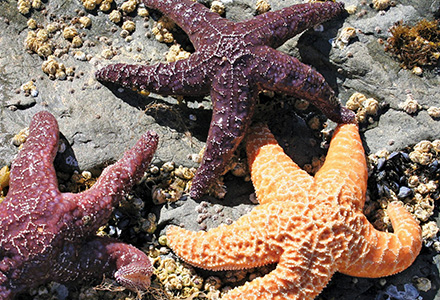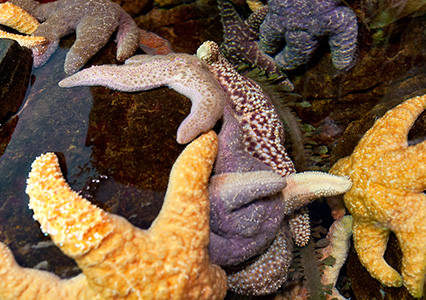If you've ever visited one of California's bountiful tidepools, chances are you've spotted a colorful and diverse array of wildlife. Life in the tidepools isn't easy, and only the most resilient animals can withstand the elements.

Sea stars are one of the rare creatures that are suited for the changing conditions that exist in tidepools. Photo courstesy of Aquarium of the Bay
By Mallory Johnson
Published: August, 2015
If you’ve ever visited one of California’s bountiful tidepools, chances are you’ve spotted a colorful and diverse array of wildlife. Life in the tidepools isn’t easy, and only the most resilient animals can withstand the elements.
Among those that are up to the task are sea cucumbers, sea anemones and (the most popular of them all) sea stars. Sea stars are remarkable animals that can handle just about anything life can throw at them. Below are 10 fascinating facts about these incredible echinoderms that everyone should know.
1.- Don’t call them starfish; sea stars are not fish, as they do not have gills, fins, or a skeleton.
2.- Sea stars are echinoderms, named for their spiny skin. They have a tough, calcified skin that acts as a protective coating from predators such as birds, fish and sea otters.
3.- There are over 1,800 species of sea stars that very in size, shape, color and texture.
4.- Sea stars are a keystone species; their very presence contributes to the health of their habitat and ecosystem.
5.- They have unique eating habits. In order to eat their food, sea stars will crawl over their meal, then carefully throw up their stomachs on top of their food to let their digestive enzymes break it down.
6.- Sea stars can regenerate their limbs. This is a useful mechanism for a sea star that finds itself in a tight spot with a predator. It can get away by dropping an arm, and later it grows a new one.
7.- While most sea stars have five arms, some species, such as the sunflower star, can have up to 40.
8.- Each arm on a sea star contains rows of tiny tubed feet that operate hydraulically. Sea stars take in water through a small hole called a sieve plate on tops of their bodies. They channel that water to their tubed feet, allowing them to extend.
9.- Sea stars use tiny muscles and suction cups on the bottom of their feet to cling to rocks and move gradually along the terrain.
10.- In order to deal with the temperature fluctuations that tidepool sea stars are exposed to, they employ a coping mechanism known as thermoregulation. They do this by taking advantage of high tides by soaking up the cold ocean water, which they later use as a buffer when exposed to direct sunlight and warm water during low tides.
Northern California is an excellent place to experience tidepools and the amazing wildlife found within them. Tidepools abound in the region, and most are easily accessible to visitors who want to learn more about the magnificent flora and fauna living there.
Another great place to learn all about sea stars and their tidepool companions is at Aquarium of the Bay, where guests can learn about these echinoderms from trained naturalists and see them during daily presentations and feedings. Visit www.aquariumofthebay.org for more info.
Mallory Johnson is the Communications Manager at Aquarium of the Bay, a nonprofit dedicated to protecting, restoring and inspiring the conservation of San Francisco Bay and its watershed.

There are over to 1,800 species of sea stars, varying in size, shape and color. Photo courstesy of Aquarium of the Bay

